Namibia
All Destinations
Namibia
Namibia is a country of startling contrasts that straddles two great deserts: the Namib (after which it is named) is the oldest desert on the planet, and its sea of red sand lies along the Atlantic coastline, while in the eastern interior lies the Kalahari, a vast and sparsely vegetated savannah that sprawls across the border into neighbouring countries.
The many national parks and game reserves boast a huge variety of wildlife in a kaleidoscope of differing environments: giraffes amble across the blinding white saltpans of Etosha National Park, Gemsbok plunge headlong up impossibly steep red dunes at Sossusvlei, and seals in their many thousands colonise lonely beachheads along the Skeleton Coast. Astonishing contrasts are everywhere for the visitor to savour, enjoy and photograph.
Namibia has rapidly become a well-known safari destination with a difference, famed for its remote and intimate lodges, interaction with the indigenous people as well as the wildlife, and offering unique opportunities to become involved with the cultural heritage of all its peoples.
Quick Facts
Capital
Windhoek
Population
2.3M
Area
825,615 sq km (318,772 sq miles)
Major Languages
English, Afrikaans, German
Major religion
Christianity, indigenous beliefs
Monetary Unit
Namibian Dollar, South African Rand
Flight time from London
10.5 hours
Time Difference
GMT + 2
When to go
January, February, March
Temperatures are extremely hot and travellers at this time of year must be ready for 40°C nearly every day. The temperatures at night stay warm but if there is going to be any rain, it will be in these months.
April, May, June
Temperatures have dropped and are now bearably hot during the day but it can get very chilly overnight, especially in the desert. Game viewing is good in Etosha but not at its peak.
July, August, September (Peak Season)
The bush is very dry so animals are concentrated at water sources, ensuring good game viewing. Vegetation is sparse and the land is very dusty. Days are pleasantly warm and nights are very cold. Early mornings and evenings are cold and crisp and a warm jacket is necessary.
October, November, December
The land is bone dry and everything is waiting for the first rains which hopefully arrive towards the end of October although parts of Namibia often do not get any rain at all. October and November are very hot and it only gets hotter from December to March.
- J
- F
- M
- A
- M
- J
- J
- A
- S
- O
- N
- D
- High Season
- Mid Season
- Shoulder Season
Highlights
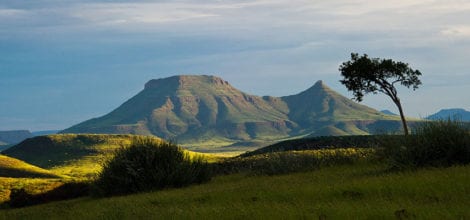
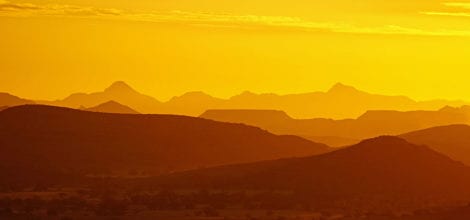
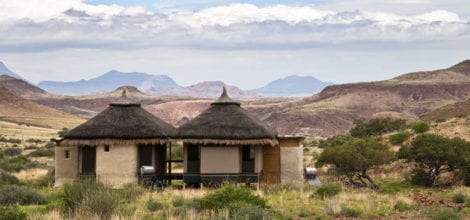
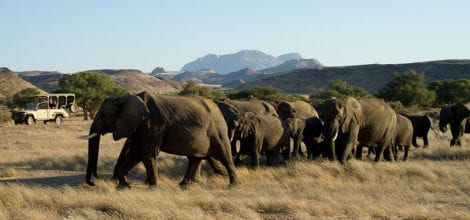
Damaraland
Damaraland is one of the most scenic areas in Namibia, a huge, untamed, ruggedly beautiful region where prehistoric water courses with open plains and grassland, massive granite kopjes and deep gorges.
Towards the west, the geography changes dramatically with endless sandy wastes, that incredibly are able to sustain small, but wide-ranging, populations of desert-adapted elephant, black rhino, giraffe, ostrich and springbok. These animals have adapted their lifestyles to survive the harshness of the sun-blistered, almost waterless desert spaces. Elephant move through euphorbia bush country, and can travel up to 70km in a day in search of food and water and unusually do not destroy trees in their quest for food. Track the desert elephant and rhino, explore the rugged land or sit back and enjoy the dramatic scenery.
Southern Damaraland, from Swakopmund up to the Huab River, has many geological and historical attractions and is a popular region for rugged off-road expeditions. The land rises slowly up towards the great escarpment and volcano-induced peaks break up the endless plains.
Northern Damaraland up to the Hoanib River has the greatest concentration of game. The terrain rumples into grassy hills dotted with mopane and acacia trees as you travel north-east over the plateau towards Etosha National Park.
Southern Damaraland
Giant inselbergs, formed millions ago when lava was all the rage, rise sheer and jagged from the barren plains of the inner Namib Desert. Most impressive of these are Spitzkoppe and the Brandberg Massif – which, in addition to being the highest peak in the country, has the allure of ancient rock paintings and the intriguing White Lady of Brandberg.
Two very large volcanic craters, also millions of years old, hold evidence of Namibia’s earliest inhabitants and, at 22km across, Messum Crater is an astonishing sight. It has lost most of its outer ring but has the most fascinating rock formations and ancient plants such as the welwitschia, a variety of lichens, lithops and other desert-adapted flora.
Near Khorixas there is a nucleus of fascinating geological formations: Vingerklip is a striking finger of rock that rises vertically out of the plains while around it the lava-formed flat-tops wouldn’t look out of place in Arizona.
The Organ Pipes are a series of dolerite pipes that, oddly enough, resemble organs pipes – though these ones were created 100 million years ago and are probably a bit out of tune by now.
Over 200 million years ago, a great flood swept enormous trees into the desert. These trees were fossilised by the sand and formed what is now a Petrified Forest.
If for no other reason than its great name, you should visit Wondergat: Gat means hole in Afrikaans.
As a result of some lava-induced chemical reaction over 100 million years ago, Burnt Mountain undergoes a spectacular transformation from dull grey to a hundred fiery reds every sunrise and sunset.
Among the red sandstone boulders and hills at Twyfelfontein is the most impressive collection of petroglyphs in Africa. Around 2,500 ancient rock paintings and engravings feature animals, tracks and abstract symbols. The exact age is unknown but archaeological evidence indicates that hunter/gatherers lived here more than 7,000 years ago.
Northern Damaraland
Northern Damaraland rises to the Etendeka Plateau and the ground becomes more vegetated as you move north-east towards Etosha National Park.
The famous desert-adapted elephants traverse this vast dry land in search of water and the world’s only naturally occurring population of black rhino co-exists with the Damara communities. The endemic black-faced impala, Damara dik-dik and Hartmann’s mountain zebra thrive in the region as do several endemic species of bird including Rüppell’s korhaan, Herero chat, Monteiro’s hornbill, bare-cheeked babbler, Carp’s tit and Hartlaub’s francolin.
Endemics aside northern Damaraland’s hilly savannah supports a large number of species including lion, leopard, cheetah, hyena, eland, kudu, giraffe, klipspringer, steenbok, gemsbok and springbok. Birdlife is prolific with over 33 raptors recorded including cuckoo hawks, Egyptian vultures and peregrine falcons – the world’s fastest animal.

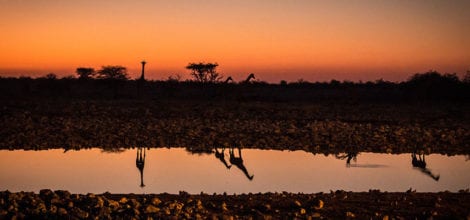
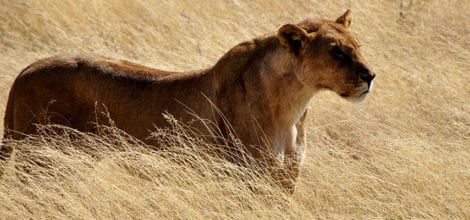
Etosha National Park
Etosha National Park is one of Southern Africa’s finest and most important Game Reserves. Etosha Game park was declared a National Park in 1907 and covering an area of 22 270 square km, it is home to 114 mammal species, 340 bird species, 110 reptile species, 16 amphibian species and, surprisingly, one species of fish.
Etosha, meaning “Great White Place”, is dominated by a massive mineral pan. The pan is part of the Kalahari Basin, the floor of which was formed around 1000 million years ago and now covers around 25% of the National Park. The pan was originally a lake fed by the Kunene River but as the course of the river changed thousands of years ago the lake subsequently dried up. The pan now is a large dusty depression of salt and dusty clay which fills only if the rains are heavy and even then only holds water for a short time. This temporary water in the Etosha Pan attracts thousands of wading birds including impressive flocks of flamingos. The perennial springs along the edges of the Etosha Pan draw large concentrations of wildlife and birds.
A San legend about the formation of the Etosha Pan tells of how a village was raided and everyone but the women slaughtered. One woman was so upset about the death of her family she cried until her tears formed a massive lake. When the lake dried up nothing was left apart from a huge white pan.
The game viewing in Etosha National Park is excellent, the best time being from May to September – the cooler months in Namibia. Visitors to Etosha Game Reserve can expect to see many buck species, elephant, giraffe, rhino and lion and more fortunate visitors will see leopard and cheetah.
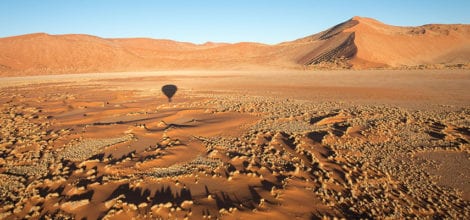
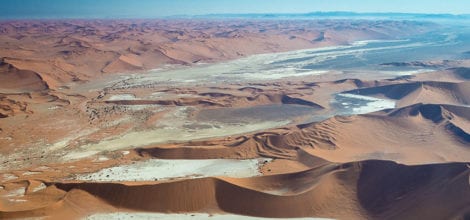
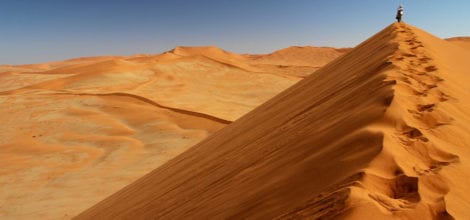
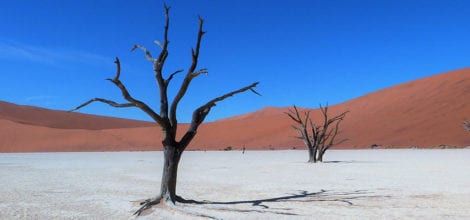
Sossusvlei
The sand dunes of Sossusvlei in the Namib Desert are often referred to as the highest dunes in the world. Various arguments are laid out to support this claim, but all miss the point, which is that Sossusvlei is surely one of the most spectacular sights in Namibia. Located in the Namib Naukluft park, the largest conservation area in Africa, and fourth largest in the world – the sand dunes at Sossusvlei are just one excellent reason to visit Namibia.
The best time to view Sossusvlei is close to sunrise and sunset; the colours are strong and constantly changing, allowing for wonderful photographic opportunities. The midday heat is intense and best spent in the shade while sunset also offers excellent photo opportunities at Sossusvlei.
‘Vlei’ is the Afrikaans word for a shallow depression filled with water (well, a depression that might sometimes be filled with water!), and the name ‘Sossusvlei’ should strictly only be applied to the pan that lies at the place where the dunes close in, preventing the waters of the Tsauchab River from flowing any further – that is, on the rare occasions that the river does flow as far as this. During exceptional rainy seasons, Sossusvlei may fill with water, causing Namibians to flock there to witness the grand sight, but normally it is bone dry. This particular ‘vlei’ is actually a more-or-less circular, hard-surfaced depression that is almost entirely surrounded by sharp-edged dunes, beyond which lies a formidable sea of rolling sand, stretching in unbroken immensity all the way to the coast. However, the name ‘Sossusvlei’ nowdays applies to the whole area – an area that encompasses the great plain of the Tsauchab River together with the red dunes that march along like giant sentinels to south and north of the plain.
The second attraction of the area is Sesriem Canyon. The canyon derives its name from the fact that early Afrikaner trekkers had to use six (‘ses’) leather thongs (a thong is a ‘riem’) so that their buckets could reach the water far below. The canyon begins as an almost imperceptible but nevertheless deep cleft in level, stony ground, and then widens until it finally flattens out onto the plain. Because it is so deep and sheltered, it often holds water well into the dry season – an invigorating sight in such a barren and stark environment.
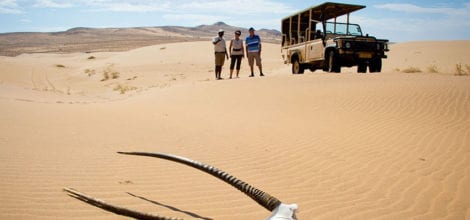
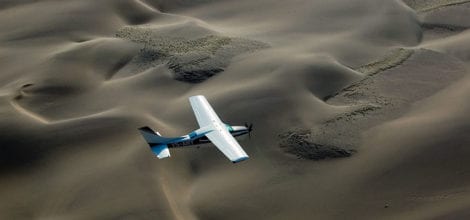
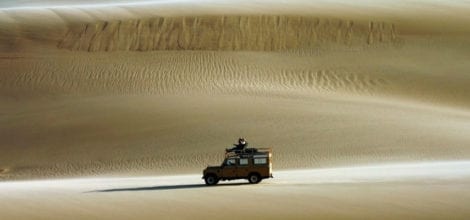

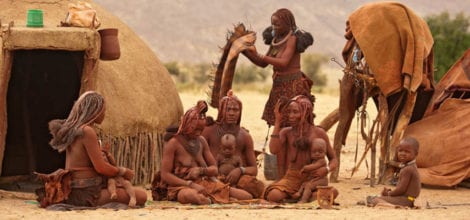
The Skeleton Coast
Although the entire coastline of Namibia was formerly called The Skeleton Coast, more commonly today it refers only to the Skeleton Coast National Park. The park stretches from the Kunene River in the north for approximately 500km to the Ugab River in the south, and protects about one-third of Namibia’s coastline.
The Kunene River rises in the remote Angolan highlands and is one of Namibia’s few perennial rivers and forms one of the country’s two permanent estuaries. The landscape includes sand dunes, canyons and mountain ranges all of which are synonymous with Namibia. The climatic conditions are not necessarily what you would expect in a desert country like Namibia – dense fog and cold sea breezes – and this is caused by the cold Benguela Current which flows offshore, meeting with the extreme heat of the Namib Desert.
The Skeleton Coast is is normally associated with famous shipwrecks, and stories abound of sailors walking for hundreds of kilometres through this barren Namibian landscape in search of food and water. The name came from the bones that lined the beaches from whaling operations and seal hunts, but more than a few of the skeletons were human. The Bushmen called it The Land God Made in Anger and the Portuguese knew it as The Gates of Hell. Ever since European navigators first discovered it, ships have wrecked on it’s off-shore rocks, or run aground in the blinding fog. While small boats could land, the strong surf made it impossible to launch, hence the stories of sailors walking through the murderous terrain.
The coast has scores of shipwrecks, some are barely recognizable, other are still in remarkably good condition. Perhaps these tragedies were meant to happen, as the wrecks provide excellent environments for Cape fur seals, living side by side with seabird colonies, offering unequaled maritime photographic opportunities.
Some wrecks of note are the Dunedin Star (a crouching skeleton was found buried nearby), Islander, Suiderkus, Sir Charles Elliot and Kaio Maru. The Seal and Luanda can be seen near Toscanini and the Atlantic Pride lies near Torra Bay. For the best views of these shipwrecks, you would need to visit the Skeleton Coast Park either on a fly-in safari or alternatively on a scenic flight.
Despite its arid and deadly appearance, the Skeleton Coast has a greater variety of species than many other parks in Southern Africa. Large mammals include Namibia’s famous desert-adapted elephant, black rhino, lion, cheetah, giraffe, gemsbok, zebra, springbok and spotted and brown hyena, are found in the dry river beds which flow from the interior of Namibia, through the Namib Desert to the Skeleton Coast.

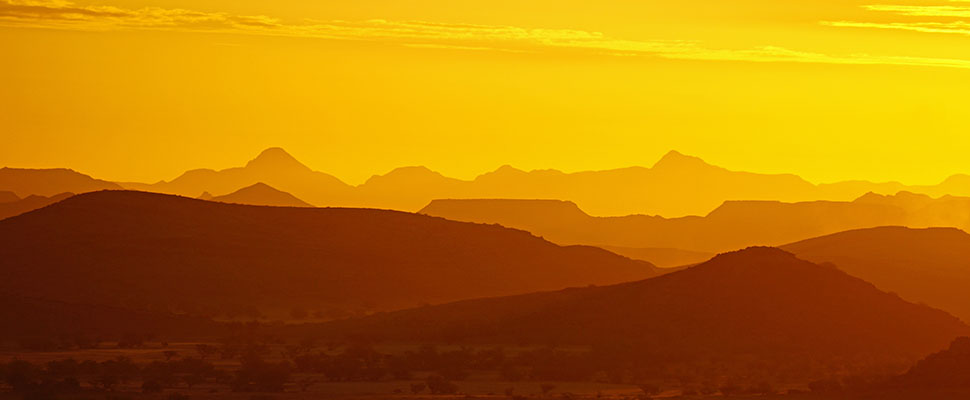
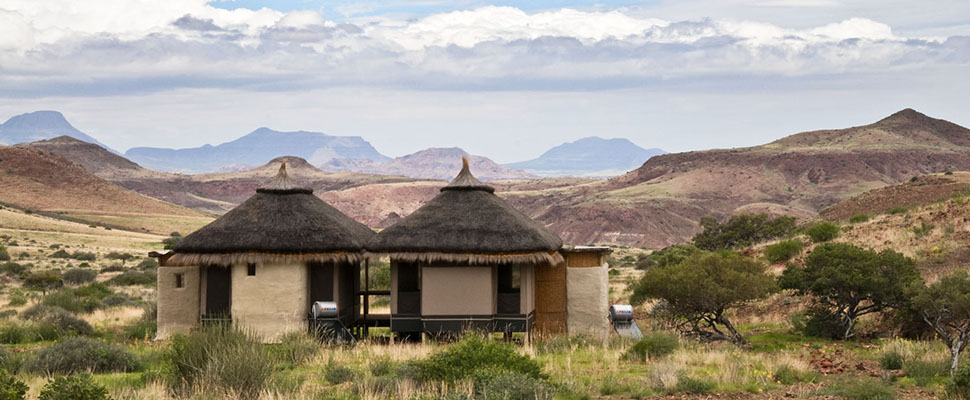

Damaraland
Damaraland is one of the most scenic areas in Namibia, a huge, untamed, ruggedly beautiful region where prehistoric water courses with open plains and grassland, massive granite kopjes and deep gorges.
Towards the west, the geography changes dramatically with endless sandy wastes, that incredibly are able to sustain small, but wide-ranging, populations of desert-adapted elephant, black rhino, giraffe, ostrich and springbok. These animals have adapted their lifestyles to survive the harshness of the sun-blistered, almost waterless desert spaces. Elephant move through euphorbia bush country, and can travel up to 70km in a day in search of food and water and unusually do not destroy trees in their quest for food. Track the desert elephant and rhino, explore the rugged land or sit back and enjoy the dramatic scenery.
Southern Damaraland, from Swakopmund up to the Huab River, has many geological and historical attractions and is a popular region for rugged off-road expeditions. The land rises slowly up towards the great escarpment and volcano-induced peaks break up the endless plains.
Northern Damaraland up to the Hoanib River has the greatest concentration of game. The terrain rumples into grassy hills dotted with mopane and acacia trees as you travel north-east over the plateau towards Etosha National Park.
Southern Damaraland
Giant inselbergs, formed millions ago when lava was all the rage, rise sheer and jagged from the barren plains of the inner Namib Desert. Most impressive of these are Spitzkoppe and the Brandberg Massif – which, in addition to being the highest peak in the country, has the allure of ancient rock paintings and the intriguing White Lady of Brandberg.
Two very large volcanic craters, also millions of years old, hold evidence of Namibia’s earliest inhabitants and, at 22km across, Messum Crater is an astonishing sight. It has lost most of its outer ring but has the most fascinating rock formations and ancient plants such as the welwitschia, a variety of lichens, lithops and other desert-adapted flora.
Near Khorixas there is a nucleus of fascinating geological formations: Vingerklip is a striking finger of rock that rises vertically out of the plains while around it the lava-formed flat-tops wouldn’t look out of place in Arizona.
The Organ Pipes are a series of dolerite pipes that, oddly enough, resemble organs pipes – though these ones were created 100 million years ago and are probably a bit out of tune by now.
Over 200 million years ago, a great flood swept enormous trees into the desert. These trees were fossilised by the sand and formed what is now a Petrified Forest.
If for no other reason than its great name, you should visit Wondergat: Gat means hole in Afrikaans.
As a result of some lava-induced chemical reaction over 100 million years ago, Burnt Mountain undergoes a spectacular transformation from dull grey to a hundred fiery reds every sunrise and sunset.
Among the red sandstone boulders and hills at Twyfelfontein is the most impressive collection of petroglyphs in Africa. Around 2,500 ancient rock paintings and engravings feature animals, tracks and abstract symbols. The exact age is unknown but archaeological evidence indicates that hunter/gatherers lived here more than 7,000 years ago.
Northern Damaraland
Northern Damaraland rises to the Etendeka Plateau and the ground becomes more vegetated as you move north-east towards Etosha National Park.
The famous desert-adapted elephants traverse this vast dry land in search of water and the world’s only naturally occurring population of black rhino co-exists with the Damara communities. The endemic black-faced impala, Damara dik-dik and Hartmann’s mountain zebra thrive in the region as do several endemic species of bird including Rüppell’s korhaan, Herero chat, Monteiro’s hornbill, bare-cheeked babbler, Carp’s tit and Hartlaub’s francolin.
Endemics aside northern Damaraland’s hilly savannah supports a large number of species including lion, leopard, cheetah, hyena, eland, kudu, giraffe, klipspringer, steenbok, gemsbok and springbok. Birdlife is prolific with over 33 raptors recorded including cuckoo hawks, Egyptian vultures and peregrine falcons – the world’s fastest animal.
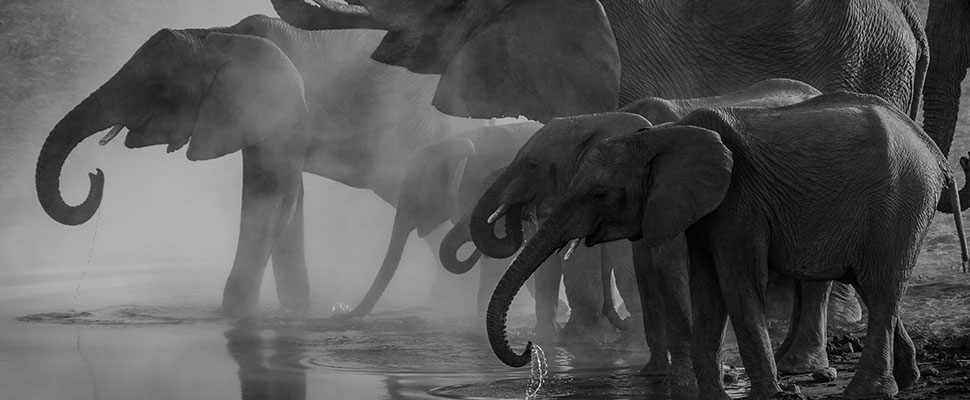
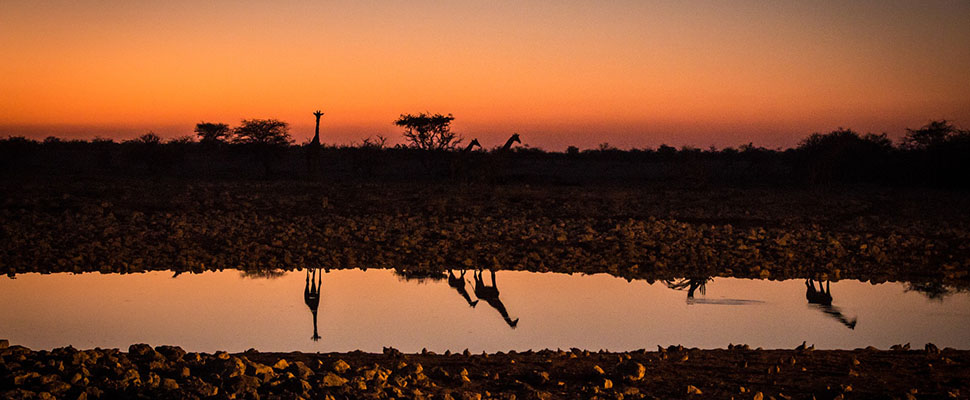

Etosha National Park
Etosha National Park is one of Southern Africa’s finest and most important Game Reserves. Etosha Game park was declared a National Park in 1907 and covering an area of 22 270 square km, it is home to 114 mammal species, 340 bird species, 110 reptile species, 16 amphibian species and, surprisingly, one species of fish.
Etosha, meaning “Great White Place”, is dominated by a massive mineral pan. The pan is part of the Kalahari Basin, the floor of which was formed around 1000 million years ago and now covers around 25% of the National Park. The pan was originally a lake fed by the Kunene River but as the course of the river changed thousands of years ago the lake subsequently dried up. The pan now is a large dusty depression of salt and dusty clay which fills only if the rains are heavy and even then only holds water for a short time. This temporary water in the Etosha Pan attracts thousands of wading birds including impressive flocks of flamingos. The perennial springs along the edges of the Etosha Pan draw large concentrations of wildlife and birds.
A San legend about the formation of the Etosha Pan tells of how a village was raided and everyone but the women slaughtered. One woman was so upset about the death of her family she cried until her tears formed a massive lake. When the lake dried up nothing was left apart from a huge white pan.
The game viewing in Etosha National Park is excellent, the best time being from May to September – the cooler months in Namibia. Visitors to Etosha Game Reserve can expect to see many buck species, elephant, giraffe, rhino and lion and more fortunate visitors will see leopard and cheetah.
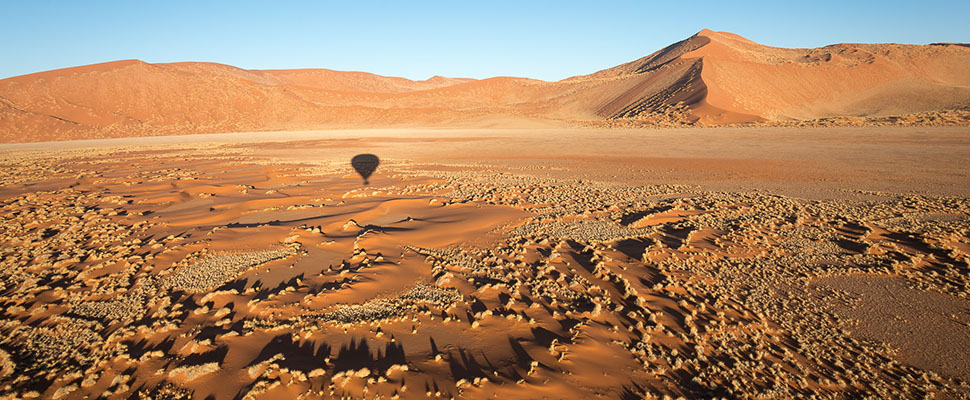
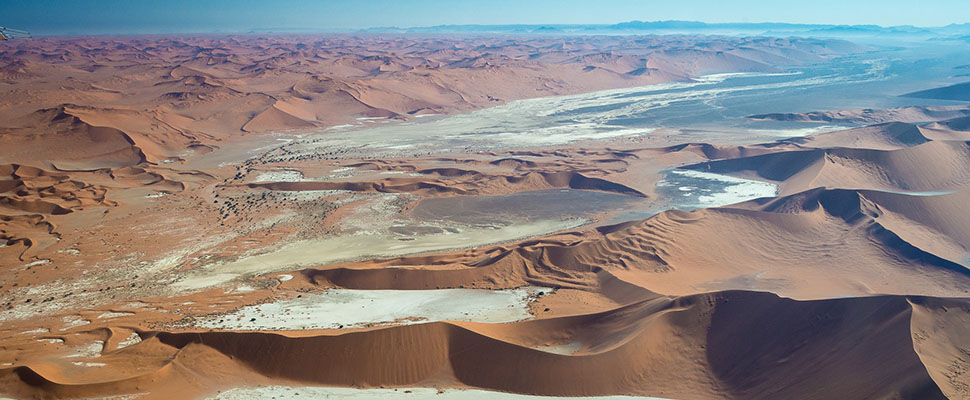
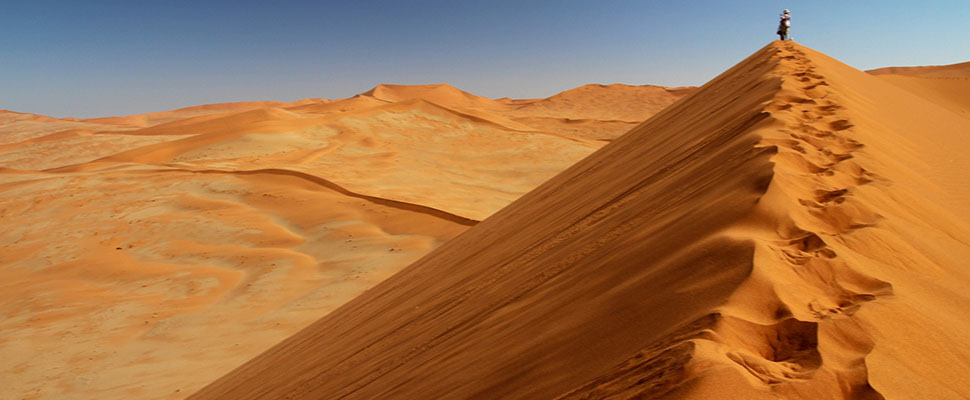

Sossusvlei
The sand dunes of Sossusvlei in the Namib Desert are often referred to as the highest dunes in the world. Various arguments are laid out to support this claim, but all miss the point, which is that Sossusvlei is surely one of the most spectacular sights in Namibia. Located in the Namib Naukluft park, the largest conservation area in Africa, and fourth largest in the world – the sand dunes at Sossusvlei are just one excellent reason to visit Namibia.
The best time to view Sossusvlei is close to sunrise and sunset; the colours are strong and constantly changing, allowing for wonderful photographic opportunities. The midday heat is intense and best spent in the shade while sunset also offers excellent photo opportunities at Sossusvlei.
‘Vlei’ is the Afrikaans word for a shallow depression filled with water (well, a depression that might sometimes be filled with water!), and the name ‘Sossusvlei’ should strictly only be applied to the pan that lies at the place where the dunes close in, preventing the waters of the Tsauchab River from flowing any further – that is, on the rare occasions that the river does flow as far as this. During exceptional rainy seasons, Sossusvlei may fill with water, causing Namibians to flock there to witness the grand sight, but normally it is bone dry. This particular ‘vlei’ is actually a more-or-less circular, hard-surfaced depression that is almost entirely surrounded by sharp-edged dunes, beyond which lies a formidable sea of rolling sand, stretching in unbroken immensity all the way to the coast. However, the name ‘Sossusvlei’ nowdays applies to the whole area – an area that encompasses the great plain of the Tsauchab River together with the red dunes that march along like giant sentinels to south and north of the plain.
The second attraction of the area is Sesriem Canyon. The canyon derives its name from the fact that early Afrikaner trekkers had to use six (‘ses’) leather thongs (a thong is a ‘riem’) so that their buckets could reach the water far below. The canyon begins as an almost imperceptible but nevertheless deep cleft in level, stony ground, and then widens until it finally flattens out onto the plain. Because it is so deep and sheltered, it often holds water well into the dry season – an invigorating sight in such a barren and stark environment.
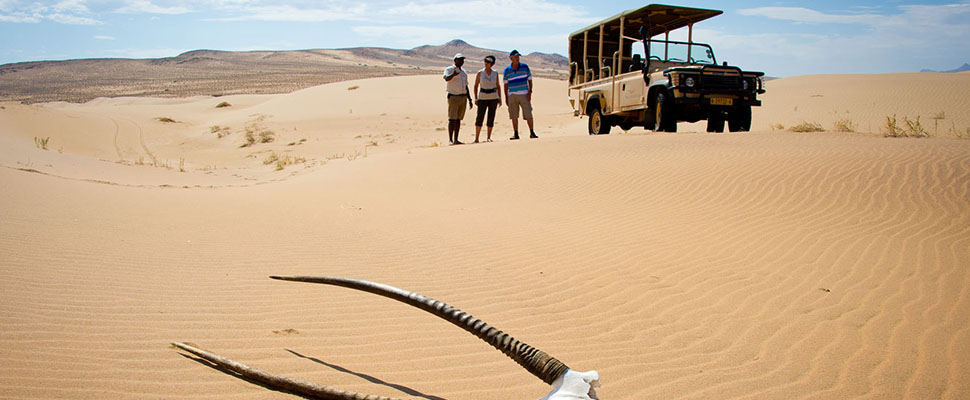
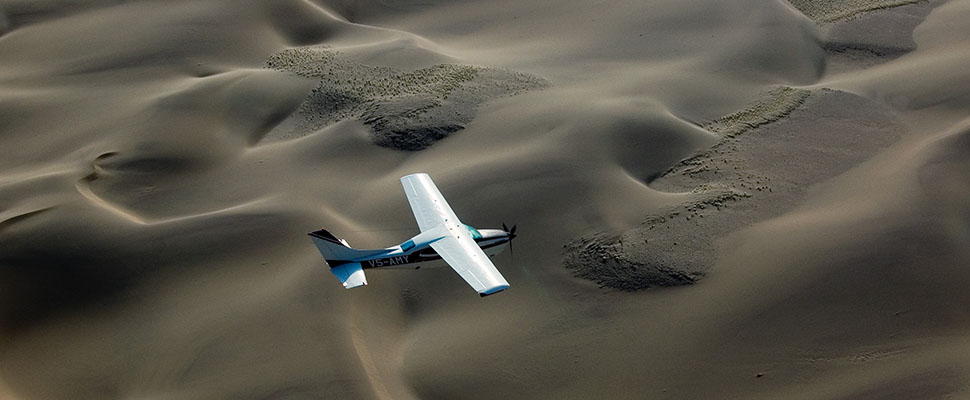
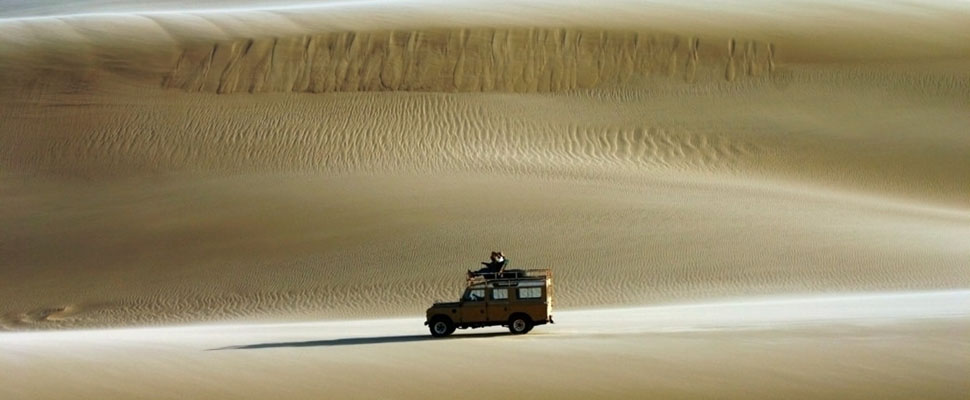
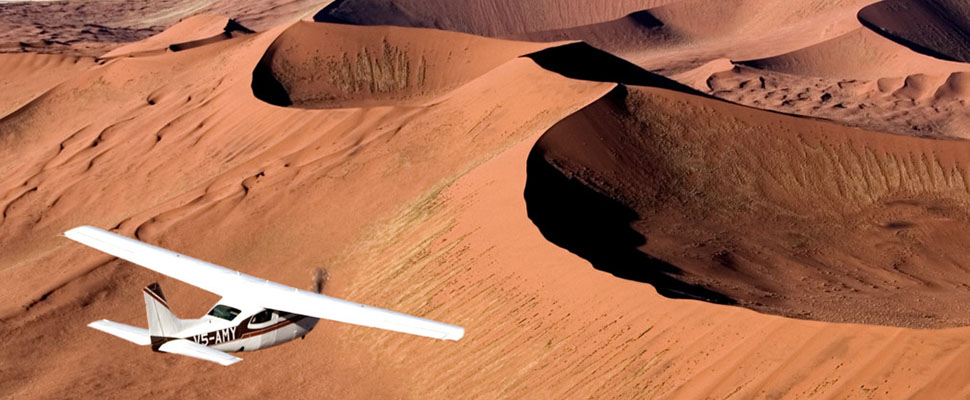

The Skeleton Coast
Although the entire coastline of Namibia was formerly called The Skeleton Coast, more commonly today it refers only to the Skeleton Coast National Park. The park stretches from the Kunene River in the north for approximately 500km to the Ugab River in the south, and protects about one-third of Namibia’s coastline.
The Kunene River rises in the remote Angolan highlands and is one of Namibia’s few perennial rivers and forms one of the country’s two permanent estuaries. The landscape includes sand dunes, canyons and mountain ranges all of which are synonymous with Namibia. The climatic conditions are not necessarily what you would expect in a desert country like Namibia – dense fog and cold sea breezes – and this is caused by the cold Benguela Current which flows offshore, meeting with the extreme heat of the Namib Desert.
The Skeleton Coast is is normally associated with famous shipwrecks, and stories abound of sailors walking for hundreds of kilometres through this barren Namibian landscape in search of food and water. The name came from the bones that lined the beaches from whaling operations and seal hunts, but more than a few of the skeletons were human. The Bushmen called it The Land God Made in Anger and the Portuguese knew it as The Gates of Hell. Ever since European navigators first discovered it, ships have wrecked on it’s off-shore rocks, or run aground in the blinding fog. While small boats could land, the strong surf made it impossible to launch, hence the stories of sailors walking through the murderous terrain.
The coast has scores of shipwrecks, some are barely recognizable, other are still in remarkably good condition. Perhaps these tragedies were meant to happen, as the wrecks provide excellent environments for Cape fur seals, living side by side with seabird colonies, offering unequaled maritime photographic opportunities.
Some wrecks of note are the Dunedin Star (a crouching skeleton was found buried nearby), Islander, Suiderkus, Sir Charles Elliot and Kaio Maru. The Seal and Luanda can be seen near Toscanini and the Atlantic Pride lies near Torra Bay. For the best views of these shipwrecks, you would need to visit the Skeleton Coast Park either on a fly-in safari or alternatively on a scenic flight.
Despite its arid and deadly appearance, the Skeleton Coast has a greater variety of species than many other parks in Southern Africa. Large mammals include Namibia’s famous desert-adapted elephant, black rhino, lion, cheetah, giraffe, gemsbok, zebra, springbok and spotted and brown hyena, are found in the dry river beds which flow from the interior of Namibia, through the Namib Desert to the Skeleton Coast.
Where to stay
These are just a selection of the properties we can personally recommend. Please get in touch to hear more about our full portfolio.
Anderssons at Ongava
Turning the focus to conservation, Anderssons at Ongava is built around Ongava Research Centre. The first of it’s kind, the research centre offers the “next generation eco-tourism” coupled with outstanding wildlife viewing.
Damaraland Camp
Visit Damaraland Camp for peace and isolation under huge blue skies, beside the auburn basalt peaks of the Etendeka Mountains. Damaraland feels as far removed from hustle and bustle as geographically possible and guests are odds-on to spot desert-adapted elephants.
Desert Rhino Camp
Set in the midst of the enormous Palmwag Reserve in northwest Namibia, Desert Rhino Camp is one of the best places to track endangered desert-adapted black rhino in the wild. Run in conjunction with Namibia Namibia’s Save the Rhino Trust, your stay contributes directly to the Rhino Trust and, ultimately, the long-term sustainability of this vulnerable habitat and its wildlife.
Etosha Mountain Lodge
Serene yet full of character, the thatched chalets of Etosha Mountain Lodge are perched on a dolomite hill offering panoramic views of the iconic Namibian landscape with an abundance of big game and wildlife.
Hoanib Valley Camp
Amongst the mountains and sand dunes of remote north-western Namibia is Hoanib Valley Camp, a joint venture between the giraffe conservation fund and local communities.
Hoodia Desert Lodge
Surrounded by majestic mountains, tranquil Hoodia Desert Lodge is ideally located just 20-minutes from the gateway to Sossusvlei. With 11 tented bungalows decorated in an earthy yet luxurious style, the lodge is a perfect base for exploring Sossusvlei’s magnificent sand dunes. Expect warm hospitality and delicious food at this family owned and run lodge.
In the Footsteps of Tusk – Namibia
Remote, vast, and lesser known than it’s neighbours, Namibia is a country that takes you further off the grid than you thought possible. Towering terra cotta sand dunes, coastal deserts, Etosha National Park with desert adapted wildlife and a specialist area where Tusk supported project Save the Rhino Namibia, are leading the way in conserving the critically endangered black rhino.
Kwessi Dunes Lodge
Kwessi Dunes Lodge is a new luxury lodge, with 12 beautiful canvas and thatched chalets, set deep in Namibia’s vast NamibRand Nature Reserve. With its rolling desert plains, backdrop of craggy mountains and iconic red dunes, this is a place where time seems to stand still and the space is never-ending.
Little Kulala
Little Kulala is an extremely stylish desert retreat among towering red sand dunes. Gravel plains and low rolling sand dunes stretch out in front of the lodge, with the iconic dunes of the Namib Desert in the distance and the Naukluft Mountains to the rear providing a dramatic backdrop.
Little Ongava
Little Ongava is quite possibly Namibia’s most luxurious and exclusive safari destination. Perched on a rocky outcrop overlooking a waterhole, Little Ongava is known for its panoramic vistas of the surrounding African savannah.
Mowani Mountain Camp
Mowani Mountain Camp is hidden amongst clusters of enormous boulders and boasts simple extraordinary desert views. Built under characteristic dome thatched roofs, there are 15 beautiful tented rooms, a dining room and lounge with sweeping views, plus a fabulous swimming pool carved out of the local boulders. The location is one of a kind, and the views across a rock strewn landscape are some of the best in Namibia.
Mushara Outpost
Mushara Outpost is all about old-fashioned hospitality with warm, friendly and personalized service on the doorstep of Etosha National Park. Based upon the elegance of an African Homestead, yet with a contemporary flavour, the lodge features eight custom made tents which nestle on the banks of an ancient dry river bed.
Namibia Horse Safaris
With over twenty years experience perfecting the art of mobile horse riding safaris, Namibia Horse Safaris is a serious riding experience in a hauntingly beautiful place. These rides have to be one of the best ways to experience the country’s varied, wild, sometimes harsh but always hauntingly beautiful, desert landscapes.
Okonjima
The family-run Okonjima Nature Reserve rests at the foot of the sandstone Omboroko Mountains, equi-distance between Windhoek, and Etosha National Park. Spanning over 200 km², this vast private reserve is equally known for frequent leopard, brown hyena and pangolin sightings, as well as being home to the AfriCat Foundation, an organization committed to the conservation of Namibia’s large carnivores.
Onguma The Fort
Onguma The Fort is the most luxurious lodge within Onguma Private Nature Reserve, along the eastern border of Etosha National Park. Entirely unique and boasting probably the finest sunset views in Namibia, this 13 suite lodge combines a classical African feel with strong Moroccan and Indian flavours, characterised by Arabesque water features, beautiful courtyards and oversized antique windows and doors.
Serra Cafema
Serra Cafema is located in the extreme north-west of Namibia on the banks of the Kunene River in the Hartmann Valley. It is an intimate, peaceful camp inspired by the area’s Himba people, with a unique mix of rustic and luxury elements, and nestled amongst shady albida trees.
Shipwreck Lodge
Located in the famous Skeleton Coast National Park Shipwreck Lodge is only 45 km from Möwe Bay this unique village of shipwreck-shaped chalets are nestled between the dunes with a view of the Atlantic Ocean where the cold Benguela current provides guests with a refreshing breeze.
Skeleton Coast Safaris
Skeleton Coast Safaris is a truly unique experience in one of the most hauntingly beautiful and unspoilt places in the world. Spend three or four nights flying and overnighting along Namibia’s dramatic Skeleton Coast in the company of the world-famous Schoeman family.
Strand Hotel Swakopmund
The four-star Strand Hotel Swakopmund is found directly on the promenade, surrounded on three sides by the Atlantic Ocean. With 125 stylish guest rooms, five unique and creative dining options, plus a pampering spa, this is a great hotel for those looking for some luxury in the coastal town of Swakopmund.
Wolwedans Dune Lodge
Wolwedans Dunes Lodge is perched on top of a red dune plateau, capturing the beauty of the desert. Built in wood and canvas, the main lodge and nine guest chalets reflect their stunning natural surroundings, with the ambience of a tented camp, yet the comfort of a permanent lodge.
Get in touch with us now to start planning your journey
Follow Us
Proudly ASSOCIATED WITH








